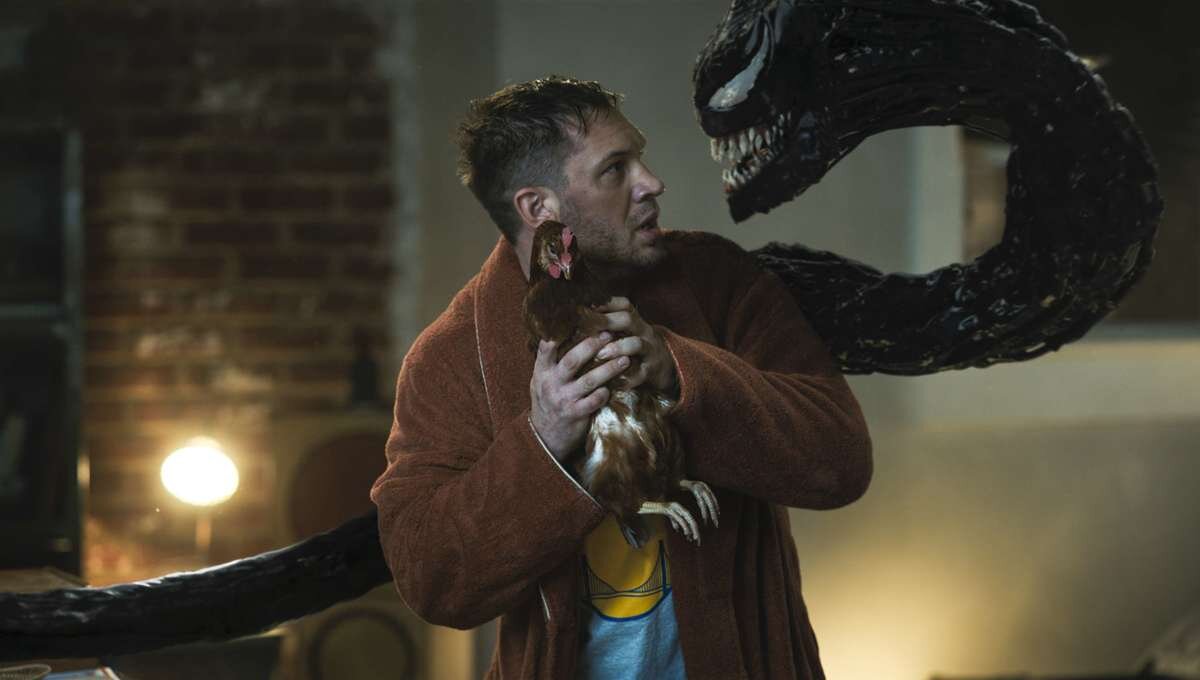Review: Venom: Let There Be Carnage (2021)
Can a campy film be satisfying if it is deliberately campy? If we follow Susan Sontag and the analysis of her seminal essay, “Notes on Camp,” the tendency would be to say no. In her work, Sontag writes that “Pure Camp is always naive. Camp which knows itself to be Camp (‘camping’) is usually less satisfying.... Probably, intending to be campy is always harmful.” And yet, here we are with Venom: Let There Be Carnage, a camp blockbuster that seems at once to embody the boldest aspects of pure camp, while being obviously and deliberately “camping” throughout its runtime.
Nowadays, most camp works are constructed with a self-consciousness that places them firmly within the latter half of Sontag’s binary classification. This is obvious in television works like Riverdale and especially in the queer art world and drag, where camp is imbued with a deliberate provocation and expression that eradicates any notion of naivety. No one would ever say that John Waters is naive in his creation of camp films, and yet, his work often has the hallmark of camp, as Sontag defines it: “the spirit of extravagance.” And so we turn back to Venom: Let There Be Carnage, the sequel to the smash hit from 2018 about a journalist (Tom Hardy’s Eddie Brock), who fuses with an alien goop (called Venom), which gives him superpowers.
All the signs point to the filmmakers, including director Andy Serkis, who takes over from Ruben Fleischer, writer Kelly Marcel, and actor Tom Hardy (who also gets story credit here), as being aware of how silly—nay—of how stupid the first Venom movie is and understanding how its pleasures are directly tied to its stupidity. This second film, which pits Eddie Brock (and Venom) against Woody Harrelson’s serial killer Cletus Kasady (who gets his own alien goop, called Carnage), doubles down on every absurd moment from the first film. It jettisons the pretensions of being a serious film early on, opting instead for cartoonish antics, although essential to the film’s effect is that the characters respond to the situation seriously. The characters are never snide nor do they ever wink at the audience with a quip to let the viewer know they’re in on the joke. But, going back to Sontag, the film and the characters do display an extravagance that is not accidental.
To be fair, some viewers, especially adolescents or adults who still consist on a diet composed mostly of comic books, video games, and Marvel movies, will inevitably still find the film cool—such is the the effect of Venom, with his big teeth, jet black design, and roguish antiheroism, on the juvenile brain. But Venom: Let There Be Carnage never tries to be cool. Rather, it is deliberate in its absurdities, more overt in its gay subtext, and more fabulously campy than the first film. It is a goofy movie with a dumb plot, but therein lies its enjoyment. The film’s operatic action, slapstick comic moments, and personal drama that plays out like a domestic comedy of errors about a gay married couple (who happen to be a human and his alien symbiote) make the film ludicrously entertaining.
Is it good? Define good. If plot coherence, clever dialogue, and emotional catharsis are the hallmarks of good entertainment, perhaps Venom: Let There Be Carnage is not good. But it’s enjoyable, especially when it detours entirely from delivering the Marvel-brand style action and instead lets its goofy characters express their earnest emotions in the loudest and most flamboyant ways imaginable.
Take a moment where Venom, who after essentially breaking up with Eddie, trashing his apartment and motorcycle, and attaching himself to random strangers, wanders into a neon-lit LGBT costume-rave in some club in downtown San Francisco and declares loudly over the microphone that he is “out of the Eddie closet.” The crowd claps and cheers and people compliment Venom on his bravery before he proceeds to strut around the club adorned with glow sticks and a giant grin on his face, the onlookers apparently assuming the seven-and-a-half foot tall alien goop is merely a costume for some recently outed dude. Is this scene clever? Coherent? Does it add anything to the narrative trajectory that puts Eddie Brock and Cletus Kasady on a collision course? Nope. But it’s hilarious, mostly because of how brazenly it expresses the gay subtext of the first film and plays into Venom as a piteous, almost cuddly, outsider who just wants to have fun and eat brains.
As Sontag instructs, “When something is just bad (rather than Camp), it’s often because it is too mediocre in its ambition.” Venom: Let There Be Carnage is not mediocre in its ambition. It is heightened and theatrical. Its climatic action scene takes place in a cathedral and takes pains to show its alien villain against a backdrop of stained glass windows, as if aspiring to connect the characters to some vision of angels and demons in comic book form. Its deployment of alien abilities in these scenes is hilariously grotesque. Venom and especially Carnage contort themselves in bizarre forms and thrash around like the fever dream of some pornographic illustrator, with their alien goop protruding in sexual ways, all gaping mouths and extruding tentacles and CGI texture that is unmistakably penile. When one character reacts to the protrusion of several red, pulsing tentacles with “That is so hot,” you have no choice but to laugh at the film’s audacity.
The actors are on the film’s wavelength. Woody Harrelson is all whispered threats and bug-eyed chaos as the villain, with a romantic subplot involving Naomie Harris’s supervillain Shriek that channels Harrelson’s work in Natural Born Killers. Michelle Williams, champ that she is, plays it straight in scenes of domestic confrontation and encouragement, in which she has to investigate whether her ex-fiance is currently possessed by an alien or compliment the alien goop talking to her in her head in order to coax him out of her. And through it all, Tom Hardy mutters and stutters and hunches and bellows and brays and gives his all to a performance of such internalized comic anguish, it’s almost masterful. I always said he’s a profoundly physical actor. He lets it show here.
If reading all this makes you assume I believe Venom: Let There Be Carnage to be some camp masterpiece, I’ve probably overstated things. But there is a refreshing flamboyance and camp spirit that makes the film preferable to most of what comes out of the MCU these days—or most superhero films in general. It’s a film of deliriously, possibly ill-conceived, vision and a robust comic earnestness that is lacking in so much contemporary entertainment. And it’s only 97 minutes long, credits and mid-credits scenes included—a refreshing breeze these days. It’s the dumbest movie I’ve seen in years and a total hoot. What else is there to say?
6 out of 10
Venom: Let There Be Carnage (2021, USA)
Directed by Andy Serkis; written by Kelly Marcel, based on a story by Marcel and Tom Hardy, based on characters created by Marvel Comics; starring Tom Hardy, Michelle Williams, Naomie Harris, Reid Scott, Stephen Graham, Woody Harrelson.



Darren Aronofsky ultimately cannot manage the tone of this black comedy crime film.